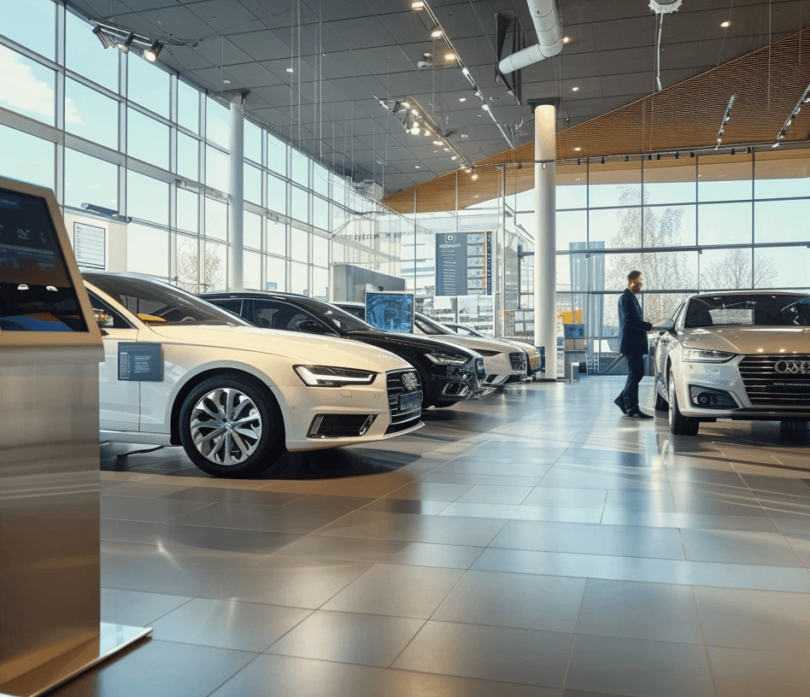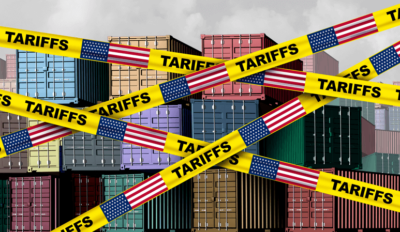Modern Conveniences for Your Dealership Showroom

Car buyers today aren’t just looking for the right vehicle—they’re looking for the right experience. They expect fast, seamless transactions everywhere else—whether they’re ordering online, transferring money through a banking app, or checking into a hotel with a mobile key. Then they visit a dealership, and suddenly, the process slows down. Too many steps, too much waiting, too many outdated systems. If buying a car feels inconvenient or frustrating, they’ll compare it to other buying experiences—and expect better.
A modernized showroom removes the friction, keeping customers engaged and the sales team focused on selling. It’s not about replacing the personal interactions that build trust—it’s about eliminating the unnecessary roadblocks that kill momentum. The more seamless the process, the faster deals get done.
Buyers don’t just hope for a smoother experience—they expect it. Dealerships that simplify the process will build stronger customer loyalty. Those that don’t? They’ll only make things harder on themselves.
In this article
Why Modern Conveniences Matter
Think about the last time you booked a flight or visited an Apple Store. The process was fast, seamless, and designed around the customer. That’s the level of convenience today’s car buyers expect. They don’t want to spend hours waiting on paperwork, sitting through repetitive conversations, or navigating a confusing showroom layout.
Here’s why keeping up with these expectations matters:
- It saves time – Buyers hate waiting. Whether it’s for financing, trade-in appraisals, or delivery, streamlined processes show respect for their time.
- It builds trust – A dealership that’s organized and transparent earns customer confidence faster than one that feels outdated or inefficient.
- It sets you apart – Modern conveniences create a competitive edge. It shows customers you’re serious about evolving with the times.
No dealership wants to be the one customers talk about because of slow, frustrating processes. The good news? Meeting these expectations doesn’t have to be overwhelming. Whether it’s integrating digital tools or optimizing showroom layout, small changes can have a big impact. Let’s break it down.
Digital Tools for a Modern Showroom
Walk into any busy dealership on a Saturday, and you’ll see it—customers waiting for a salesperson, staff scrambling to find inventory details, and deals getting delayed by slow processes. The right technology doesn’t replace the personal sales experience—it removes friction so the sales team can focus on closing deals instead of answering basic questions or hunting for information.
- Digital Kiosks: When your showroom is packed, customers don’t want to stand around waiting for help. Kiosks let them browse inventory, check pricing, and schedule test drives on their own, keeping them engaged instead of frustrated. These tools don’t replace your team—they make sure buyers stay interested while salespeople focus on serious prospects.
- Interactive Displays: Today’s buyers love customization and comparison. With touchscreen displays, they can explore vehicle features, compare models, and even visualize their ideal build before ever talking to a salesperson. This keeps customers engaged and gives them more confidence in their choices..
- Mobile-Friendly Tools for Staff: Nothing kills momentum like a salesperson walking away to check inventory or pricing. Equipping the team with tablets lets them pull up financing options, trade-in estimates, and real-time availability on the spot—keeping the process fluid and preventing unnecessary delays. No more “Let me check on that and get back to you.”.
- Digital Signage: Instead of static posters that get outdated, digital signage allows dealerships to instantly update promotions, highlight new arrivals, or display real-time financing offers. It keeps customers engaged while also reinforcing key marketing messages without extra printing costs.
Technology should keep customers moving forward, not slow them down. But if your showroom layout is cluttered, confusing, or outdated, even the best digital tools won’t help. Let’s talk about how to create a space that actually works for both your customers and your team.
Enhancing Physical Spaces for Convenience
A showroom’s layout can either keep things moving or slow everything down. When a customer walks in, they should instinctively know where to go—whether they have an appointment, are finalizing paperwork, or just stopped by to check out a car. If the space isn’t intuitive, you’ll see it—the quick pause, the glance around, the hesitation before they flag someone down to ask where to go.
Think about how customers actually move through your dealership. Are they stuck waiting too long? Do they linger near the front desk, unsure of what to do next? Or do they feel at ease, knowing exactly where to go and what to expect next?
Every detail—from your waiting area setup to showroom signage—plays a role in keeping customers comfortable and the buying process moving forward. Here’s where small changes can make a big difference.
- Make Waiting Areas Work for You, Not Against You: Let’s be honest—nobody likes waiting, but it’s part of the dealership experience. The key is keeping people comfortable and engaged so they don’t get frustrated. Comfortable seating, fast Wi-Fi, and charging stations are table stakes at this point. Throw in some good coffee, a few snacks, and a TV playing something other than a finance news channel, and you’ve got a space where customers don’t mind hanging out. Got families coming in? A small kid-friendly corner can keep parents focused instead of chasing their toddler around the showroom.
- Don’t Make Customers Wander Around Lost: Ever see a customer standing in the middle of the showroom looking around like they’re lost in a parking garage?That’s a problem. Good wayfinding signage should guide people without them having to ask for directions. Whether it’s test drives, service check-ins, or financing, clear pathways and signage help keep customers moving where you want them to go—without confusion or wasted time.
- First Impressions Matter—Make the Showroom Feel Premium: The moment a customer walks in, they’re forming opinions—not just about the cars, but about the dealership itself. A clean, well-lit showroom with a modern layout and branding tells them this place is professional and well-run. On the flip side, if your showroom looks dated, messy, or thrown together, customers subconsciously start questioning the quality of the experience and even the pricing. Private meeting rooms also set the right tone for financing conversations—nobody wants to negotiate big financial decisions in a noisy, high-traffic area.
But even the best-designed space can only do so much. If customers are still waiting on financing approvals or trade-in appraisals, frustration sets in fast. That’s where automation can make all the difference.
Improving Efficiency with Automation
Every dealership has those frustrating bottlenecks—the moments that slow down the deal, test a customer’s patience, and pull staff away from higher-value interactions. Long waits at check-in, back-and-forth trade-in negotiations, stacks of paperwork, or scheduling mishaps—all of these can stall momentum and hurt the experience.
That’s where automation steps in—not to replace customer service, but to speed up the parts of the process that don’t need to be manual. The goal? Keep things moving while letting the sales team focus on closing deals, not getting bogged down in admin work.
Here’s where automation can make the biggest impact:
- Faster Service Check-Ins Without the Line: Nobody likes waiting in line just to check in for a service appointment. With self-service kiosks or mobile check-in, customers can scan a QR code or enter their info on their phone before they even step inside: Less congestion, faster processing, and service advisors can spend more time actually helping customers instead of handling check-ins.
- Trade-In Estimates in Minutes, Not Hours: We’ve all seen it—a customer gets a rough trade-in estimate online, then walks into the dealership only to start the process over again. Trade-in valuation kiosks and instant appraisal tools bridge that gap, giving customers quick, reliable estimates while they browse inventory. No more back-and-forth, just a smoother handoff to the sales team.
- Test Drives Without the Hassle: Customers don’t want to wait around for a salesperson just to schedule a test drive. QR codes or online scheduling tools let them book their own test drives in advance, keeping things moving and preventing double-bookings. It also helps dealerships manage scheduling more efficiently, especially on busy weekends.
- CRM & Automated Follow-Ups That Feel Personal: A good CRM system does more than just store customer data—it helps sales teams stay proactive. When follow-ups are automated based on customer interactions, reps don’t have to remember every detail manually. Instead, the system triggers timely reminders about financing offers, upcoming service appointments, or vehicle promotions—keeping customers engaged without feeling like they’re being spammed.
But even with the best automation tools in place, there’s still a bigger challenge—making sure online and in-store experiences connect seamlessly. If a customer has to start from scratch when they walk into the dealership, all that efficiency goes out the window. That’s a problem. Let’s take a closer look at how to bridge that gap.
Benefits of Integrating Online and In-Store Experiences
Buyers today don’t just show up and start shopping. By the time they step into the showroom, they’ve already done their homework—researching models, getting pre-approved for financing, and even reserving vehicles. But when the in-store experience doesn’t sync with what they’ve already done online, that’s when frustration kicks in.
No customer wants to feel like they’re starting over. They don’t want to spend time filling out forms they’ve already completed or explaining their financing details again. The dealerships that connect the dots between online and in-store interactions create a seamless, low-friction experience that customers appreciate—and reward with their business.
Seamless Transitions That Save Time
When a buyer has already spent time online, the last thing they want is to repeat the process in person. A disconnected experience slows things down and creates unnecessary frustration. By integrating digital tools with in-store processes, you eliminate redundant steps and keep the momentum going.
In fact, a recent car buyer journey study found that buyers who completed more of their transaction online spent an average of 42 minutes less at the dealership, making the process smoother and more enjoyable. And it’s not just about saving time—it’s about improving customer satisfaction. The same study found that new-vehicle buyers reported a record 75% satisfaction rate—the highest in the study’s history.
What’s driving this increase? A smoother, more connected buying process. Customers aren’t just expecting online convenience—they’re actively rewarding dealerships that deliver it.
Think about it this way:
- A customer applies for financing online, so when they walk in, they’re ready to sign, not waste an hour on paperwork.
- A buyer reserves a vehicle online, so instead of waiting for a salesperson to track it down, it’s already prepped and waiting for a test drive.
- A trade-in appraisal is completed in advance, so the customer walks in with a realistic valuation, making negotiations easier and faster.
Why It’s a Win for Your Dealership
- Happier Customers: A faster, smoother buying process keeps customers engaged and and more satisfied with their experience.
- More Efficient Sales Team: When basic steps are handled online, sales staff can focus on what actually matters—helping customers choose the right vehicle and closing deals.
- Higher Closing Rates: A frictionless transition from online to in-store keeps buyers moving toward a purchase instead of second-guessing their decision.
The bottom line? When online and in-store experiences are in sync, the process feels natural for the customer—and more profitable for the dealership. But digital convenience alone isn’t enough. The real differentiator is what happens when the customer steps through the door. Let’s talk about the human side of the experience.
Modern Conveniences Beyond Technology
Technology can speed up the process, but it’s the personal touches that leave a lasting impression. Customers don’t just remember the price they paid—they remember how they were treated. A great deal won’t bring them back if they felt like just another number. The best dealerships go beyond transactions and create experiences that build loyalty.
- Personalized Service: Customers appreciate when sales teams acknowledge their preferences and history. A simple greeting by name or recalling a past purchase can turn a routine visit into a relationship. When a returning customer hears, “Welcome back! Are you still loving that Tahoe you bought last year?” it makes a difference.
- Special Amenities: Small conveniences go a long way in making customers feel valued. Offering valet parking, complimentary refreshments, or even home delivery for busy professionals shows that the dealership respects their time. Customers aren’t just comparing prices—they’re comparing experiences.
- Community Events & Test Drive Experiences: Hosting VIP test drive days, exclusive new model showcases, or service department appreciation events keeps the dealership top of mind. Events like these aren’t just about selling cars—they’re about reinforcing the dealership’s presence in the community and giving customers a reason to come back before they need their next vehicle.
- Follow-Up That Feels Genuine: Instead of automated generic messages, sending a personalized check-in call, text, or email after a sale or service appointment shows customers they weren’t forgotten the moment they drove off the lot. Instead of generic “How’s your car?”messages, make it specific: “We noticed you came in for service last week—how’s it running? Let us know if you need anything.”
The dealerships that win aren’t just selling cars—they’re creating experiences that customers want to return to. When you combine modern technology with meaningful personal service, you don’t just close deals—you build relationships that drive long-term success.
The Dealerships That Win Make Buying Easy
The goal isn’t to change the way cars are sold—it’s to make the process work better for both customers and the dealership. Less frustration, more engagement, and ultimately, higher profitability. The dealerships that embrace small but meaningful upgrades—whether through digital tools, reducing wait times, or thoughtful personal touches—will be the ones that lead the industry forward.
This isn’t about flipping a switch overnight. Most of these changes can be phased in gradually, in ways that make sense for your store. The key is to focus on what improves the customer experience without adding complexity—because when the process is smoother for them, it’s more profitable for you.
The best dealerships don’t just sell cars; they create an experience that keeps buyers coming back and referring others. What’s one simple change you can start with today?



